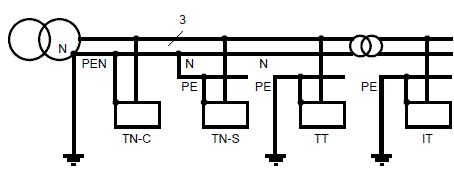سیستمهای مورد نظر شما سیستمهای زمین مورد استفاده در شبکه های فشار ضعیف می باشند. زمین نقش عمده ای در انتخاب و مراعات الزامات حفاظتی بویژه در سیستمهای متنوع فشار ضعیف بازی می کند. سیستم TN تعریف شده در استاندارد IEC 60364 به زیر سیستمهای زیر قابل تقسیم است.  برخی ملاحظات حفاظتی مرتبط با سیستمهای TN به شرح زیر قابل توجه است.
برخی ملاحظات حفاظتی مرتبط با سیستمهای TN به شرح زیر قابل توجه است.  With circuit-breaker: Circuit-breaker tripping occurs at a level determined by the type of the tripping release (see fig. below ). As soon as the fault current exceeds the threshold of the short-circuit protection trip release (generally “instantaneous”), opening occurs in a time far shorter than specified maximum breaking time, for example 5 s for distribution circuits and 0.4 s for terminal circuits. When impedance of the source and cables is high, either low threshold trip releases must be used or RCDs associated with the SCPDs. These RCDs may be separate residual current devices or be combined with circuit-breakers (residual current circuit-breakers) of low sensitivity. Their threshold must be:
With circuit-breaker: Circuit-breaker tripping occurs at a level determined by the type of the tripping release (see fig. below ). As soon as the fault current exceeds the threshold of the short-circuit protection trip release (generally “instantaneous”), opening occurs in a time far shorter than specified maximum breaking time, for example 5 s for distribution circuits and 0.4 s for terminal circuits. When impedance of the source and cables is high, either low threshold trip releases must be used or RCDs associated with the SCPDs. These RCDs may be separate residual current devices or be combined with circuit-breakers (residual current circuit-breakers) of low sensitivity. Their threshold must be:  Use of a RCD has the advantage of making loop impedance checking unnecessary, a fact which is of particular value when the installation is modified or extended. This solution is clearly not applicable with a TN-C type earthing system (the protective conductor being the same as the neutral one). With fuses: The fuses used for short-circuit protection are of the gG type and their time/current characteristics (see fig. below ) are defined by standards (household fuses: IEC 60241, industrial fuses: IEC 60269). Checking suitability with the maximum specified breaking time therefore calls for individual validation of the ratings provided for each protection device. If they are not suitable, either fault loop impedance must be reduced (increased cross-sections) or the fuse must be replaced by a low threshold or a residual current circuit-breaker.
Use of a RCD has the advantage of making loop impedance checking unnecessary, a fact which is of particular value when the installation is modified or extended. This solution is clearly not applicable with a TN-C type earthing system (the protective conductor being the same as the neutral one). With fuses: The fuses used for short-circuit protection are of the gG type and their time/current characteristics (see fig. below ) are defined by standards (household fuses: IEC 60241, industrial fuses: IEC 60269). Checking suitability with the maximum specified breaking time therefore calls for individual validation of the ratings provided for each protection device. If they are not suitable, either fault loop impedance must be reduced (increased cross-sections) or the fuse must be replaced by a low threshold or a residual current circuit-breaker. 
